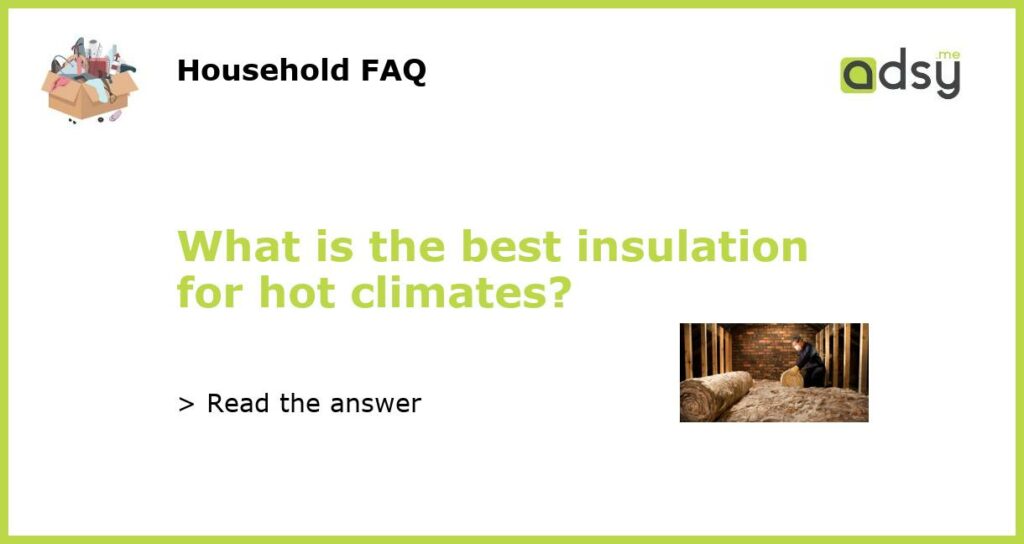Insulating your home in a hot climate: what is the best solution?
Living in a hot climate can be challenging, especially when it comes to keeping your home cool and comfortable. One of the most effective ways to combat the heat is by insulating your home properly. However, not all insulation is created equal, and some types are better suited for hot climates than others. In this article, we will explore the best insulation options for hot climates and discuss their benefits and drawbacks.
Spray foam insulation: a top choice for hot climates
Spray foam insulation is often considered to be the best option for hot climates due to its high thermal performance and ability to create an effective air barrier. This type of insulation is applied as a liquid and expands to fill the space, creating a continuous thermal envelope. The air sealing properties of spray foam insulation help prevent the infiltration of hot outside air, reducing the need for excessive cooling and minimizing energy costs.
Additionally, spray foam insulation has a high R-value, which is a measure of its thermal resistance. This means it provides superior insulation and helps keep your home cool even in extreme heat. Another advantage of spray foam insulation is its ability to fill gaps and cracks, providing an airtight seal that prevents hot air from entering your home and cool air from escaping.
Reflective insulation: harnessing the power of the sun
Reflective insulation is another excellent option for hot climates. This type of insulation works by reflecting radiant heat away from your home, reducing the amount of heat that enters the building. Reflective insulation is typically installed in the attic and works best when there is an air gap between the insulation material and the roof. The air gap acts as an extra layer of insulation, further reducing heat transfer.
Reflective insulation is made from materials with a highly reflective surface, such as aluminum foil. It is effective at reducing heat gain during the day and can also help prevent radiant heat loss at night. While reflective insulation is not as effective at insulating against conductive or convective heat transfer, it is a cost-effective solution for hot climates where radiant heat is the primary concern.
Fiberglass insulation: a versatile and budget-friendly option
Fiberglass insulation is one of the most common types of insulation and can be used in both hot and cold climates. It is made from tiny glass fibers that are spun into a wool-like material. Fiberglass insulation comes in batts or rolls and is installed between wall studs or ceiling joists.
While fiberglass insulation is not as effective at reducing heat transfer as spray foam or reflective insulation, it still provides a significant level of thermal resistance. It is also more budget-friendly compared to other insulation options, making it a popular choice for homeowners on a tight budget. However, it is important to install fiberglass insulation properly to ensure maximum efficiency and effectiveness.
Radiant barrier insulation: blocking the sun’s heat
Radiant barrier insulation is an effective solution for hot climates as it reflects radiant heat away from your home. It consists of a highly reflective material, typically aluminum, that is installed on the underside of the roof. This reflective surface prevents heat from entering the building and keeps your home cooler.
Unlike other types of insulation, radiant barriers work by reducing radiant heat transfer rather than air infiltration. They are most effective in hot climates with high levels of sun exposure. It is important to note that radiant barriers are typically used in conjunction with other types of insulation to provide comprehensive thermal protection.
Proper installation and ventilation: key factors for success
Regardless of the insulation type you choose, proper installation and ventilation are crucial for achieving the best results in a hot climate. Poorly installed insulation or inadequate ventilation can compromise its effectiveness and overall energy efficiency.
When insulating your home, it is recommended to hire a professional contractor who has experience working with the specific insulation type you have chosen. They can ensure that the insulation is installed correctly, without any gaps or voids that could allow unwanted heat transfer.
In addition to proper insulation installation, maintaining good ventilation is essential to prevent the buildup of heat and moisture in your home. This can be achieved through the use of exhaust fans, attic vents, and well-designed HVAC systems.
To conclude, the best insulation for hot climates depends on various factors such as your budget, the level of insulation required, and the location of your home. Spray foam insulation, reflective insulation, fiberglass insulation, and radiant barrier insulation are all viable options, each with its own advantages and disadvantages. By considering these factors and consulting with a professional, you can choose the insulation type that will best suit your needs and help keep your home cool and comfortable in even the hottest climates.

